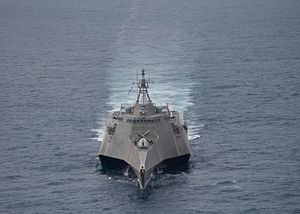Trans-Pacific View author Mercy Kuo regularly engages subject-matter experts, policy practitioners, and strategic thinkers across the globe for their diverse insights into U.S. Asia policy. This conversation with Admiral James Stavridis – dean of the Fletcher School at Tufts University; former Supreme Allied Commander, NATO and commander of U.S. European Command (2009-2013); and author of Sea Power: The History and Geopolitics of the World’s Oceans – is the 100th in “The Trans-Pacific View Insight Series.”
Assess the role of sea power – past, present, and future – in U.S. maritime leadership.
As I write about in Sea Power: The History and Geopolitics of the World’s Oceans, (Penguin Press, 2017), global history so often reflects whether or not a nation or empire has effective control. From the Peloponnesian Wars 2,500 years ago to the Cold War, the ability of nations to ensure access to the global commons matters deeply, both in peace and war. The oceans matter today because of the environmental and ecological challenges (acidification, global warming, melting Arctic ice, falling fish stocks); because of trade (95 percent of all internationally traded goods move by sea); and geopolitically as great powers contest the seas for the first time since the fall of the Berlin Wall and the end of the Cold War. Sea power continues to matter deeply to American power around the world.
How should the U.S. as a Pacific power exercise sea power in Asia?
We should do all we can to work through and with our allies (Japan, South Korea, Australia, New Zealand, Thailand, the Philippines) and our friends (India, Singapore, Malaysia, Vietnam, and many others). By operating coherently with maritime allies, we can best stymie Chinese claims to “owning” the South China Sea, stand up to North Korean provocations, and balance Russian activities and intrusions. A key axis will be India-Japan-United States as a counter-balance to China. We should seriously consider returning to the concept of the Trans-Pacific Partnership, which would bind together our friends and partners in the largest free-trade zone in world history.
Another aspect of U.S. sea power is the forward deployment of our carriers and Marines throughout the Western Pacific, again working from bases granted by our allies in Japan, South Korea, Australia, and on U.S. pacific territories (principally Guam). By using political, economic, military, and cultural tools in the Pacific, we can best continue our status as a key Pacific and maritime power.
What is the impact of information technology on sea power, e.g. the interplay of cyber and maritime security?
Increasingly the shift to cyber and informational based maritime power appears more profound than the shift from wooden ships and sails to steel and turbine propulsion a century ago. We have both defensive and offensive capabilities connected to our seagoing forces, and must think of each warship as a cyber platform just as we do as a base for Tomahawk launches. Likewise, our ships are as vulnerable to electrons in the cybersphere as they are to hypersonic cruise missiles. We need to train and education our Sailors so they appreciate the danger in this sphere as surely as they do an approaching tsunami. The Navy has stood up a numbered fleet, the 10th Fleet, to focus on cyber, information, and intelligence and how they link together to create the ability to conduct effective sea power.
Identify three over-the-horizon geopolitical risks facing U.S. sea power.
The three key over-the-horizon geopolitical risks facing U.S. sea power are easy to identify: the rise of the Chinese blue-water navy, with aircraft carriers, capable of true deep ocean offensive power projection information; the resurgence of the Russian Navy, especially with advanced submarines, high speed cruise missiles and torpedoes, and unmanned vehicles; and the rise of cyber warfare tools that are accessible to even smaller but offensively minded nations – North Korea, Iran, Syria – which can threaten our fleet in asymmetric ways.
Explain the long-term strategic relevance of U.S. leadership in the Asia Pacific.
If the United States is pushed out of Asia, presumably by China, we would gradually lose our influence in that crucial part of that world. Given the demographics of Asia, which includes India in the Pan-Indo-Pacific theater, the balance of world population and productivity will continue to shift west. By fading from the Pacific, we will allow China to inexorably dominate the region, to include consolidating their claim to territorial ownership of the entire South China Sea – with millions of barrels of oil and billions of cubic square feet of natural gas. China will have a carte blanche to dominate our allies, partners, and friends, control critical sea lanes of communications, and dictate political events. This would effectively close the United State out of global leadership, bringing an end definitively to the “American Century.” Big doors swing on small hinges, and the loss of U.S. sea power in the Pacific would greatly diminish American power globally.

































